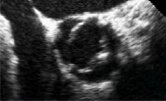A bicuspid aortic valve is formed when the main outflow valve of the heart develops with two opening leaflets rather than three.

How common is it?
A bicuspid aortic valve is found in approximately 1 in 50 of the population
What symptoms might I get?
Usually none. A bicuspid aortic valve however is more prone to become narrow and/or leaky. If these occur then it can result in symptoms of breathlessness.
Will I need treatment?
If the valve function deteriorates and the valve becomes severely narrowed or leaky then surgery can be recommended to replace the valve.
What extra tests are required?
Some patients will need a transoesophageal echocardiogram to examine the valve function in more detail and a computed tomography (CT) scan to look at the main blood vessel (aorta).
Is it hereditary?
Occasionally. Screening of immediate family members may be recommended.
Does this affect my life expectancy?
If the aortic valve deteriorates and is not treated then this can affect your life expectancy. With modern treatment and appropriate use of surgery however, life expectancy should not be affected.
What happens next?
If you have been diagnosed with a bicuspid aortic valve then you should see your GP who can arrange a referral to your local cardiologist if required.
Useful links
http://en.wikipedia.org/wiki/Bicuspid_aortic_valve